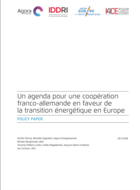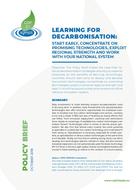The new IPCC report on limiting global warming to +1.5°C has highlighted that all countries need to step up efforts to honour the goals of the Paris Agreement on climate change. Europe is not exempt from this conclusion. Current EU objectives aim to reduce emissions by 40% by 2030 and 80% by 2050 compared to 1990 levels. However, this is not enough. The Paris Agreement calls for a balance between GHG emissions and sinks by the second half of the century to ensure staying well below 2°C (“GHG neutrality”).
Meanwhile, the IPCC concludes that striving for 1.5°C globally implies net zero CO2 emissions globally by around 2050, as well as deep reductions of all other greenhouse gases. Any reasonable translation of these benchmarks to Europe suggests that much more ambition is needed than what is expressed in current targets1 . Hence the current calls for the EU to aim for net zero GHG emissions by 2050, if not sooner.
The mid-century strategy: an essential step towards making EU climate action Paris-compatible
In this context, the EU’s European Commission is preparing a new mid-century greenhouse gas emissions reduction strategy (“MCS”), as encouraged by Art. 4.19 of the Paris Agreement. The first elements, some of which have already leaked, are due to be finalised and published in late November, ahead of the next climate summit in Katowice (Poland).
The goal of the document is to help clarify two things. First, how the EU should translate the ambition of the Paris Agreement into its own long-term goals for reducing emissions (as current targets were set before the Paris Agreement). Secondly, what the feasible pathways are to implementing those long-term goals, both from a techno-economic perspective, but also accounting for other real world issues, like social acceptability, finance, etc.
While it will not be legally binding on Member States, both the content and the process of the MCS have major political importance. For instance, it is crucial that the EU is seen to honour the full ambition of the Paris Agreement to remain a climate leader among developed countries, particularly in the context of the US’ disengagement. That means exploring scenarios consistent with Europe’s fair share of striving for 1.5°C and this implies aiming for something like reaching net zero GHG emissions by 2050.
The vision of a GHG-neutral European economy that the MCS sets out will also be crucial to framing a concrete discussion on how to increase EU ambition in the short term. The Paris Agreement calls on parties to revise their ambition in their current “nationally determined contributions”, or NDCs, every five years. Thus, there is an ongoing discussion in Brussels with Member states about the need for the EU to thus revise its ambition already in 2020 and potentially again by 2025. The MCS is essential for this discussion, as it can help to highlight what sectoral, technological and behavioural transformations need to be additionally pursued or enhanced in order to put the EU on track towards GHG neutrality by 2050.
While it should not be an unproductive debate about “burden sharing”, the MCS should also help to inform a debate in the EU’s Member States about what the ambition of Paris and the EU’s collective strategy might imply for their own national strategies.
Member state “buy in” is crucial
The MCS’ adoption will not be easy. Member States are starting from different places, in terms of average income per capita, current energy mix, political economy challenges, etc. Consequently, views differ widely between them on basic issues, like how much ambition is desirable and on the optimal pathways for getting there. In fact, a similar exercise was voted down by coal-dependent Poland in 2011.
But in one sense, revealing points of contention is the point of the whole exercise. The EU will ultimately need each Member State to sign up to and implement its mid-century vision “on the ground”. This will require convincing Member States who are on the fence that its vision is possible for them to implement. Member States need to see a vision of a decarbonised economy that they can sign up to and that looks doable for them.
Bringing the debate to the national level
This in turn raises a question about the process of how the EU engages with Member States to illicit the relevant information. An unavoidable problem with the process of drafting the initial version of the MCS is that, due to time and resource constraints, it has thus far been a largely Brussels-based exercise. This has arguably been a weakness of past EU roadmap efforts, which have struggled to get traction beyond Brussels.
During 2019, as progress is delayed due to European parliamentary elections, there is thus a need for a more sustained engagement at national level. In addition to promoting the MCS and its importance, the process of national engagement could aim to identify three fundamental elements of the final document
- The key areas of convergence and divergence between existing national long-term perspectives to achieve Paris and that of the Commission’s “first draft”.
- The reasons for these differences, identifying where they reflect materially important issues that need addressing to get member state sign up.
- The possible solutions for resolving those issues in subsequent policy development.
These should be elements of a mid-century strategy that can be a genuine basis for a shared vision on climate mitigation.
Of course, it might still be unrealistic to expect that all sources of disagreement will be resolved by the process described above. There will therefore be further work to be done, especially at Member State level, to fill analytical gaps and facilitate more-informed dialogue on unresolved issues. New information will also need to be integrated as the future is uncertain. The MCS should not be seen as an end-point, but rather an on-going and iterative process.
Next steps
A Commission’s option paper and modelling of alternative scenarios will be released in late November and presented at COP24 in Katowice in December. The MCS will be debated in the EU Council in March 2019 and likely modified during 2019, before hopefully being adopted by the EU Parliament and Member States and submitted to the UN Framework Convention on Climate Change. In light of European elections in mid-2019, it is possible that this process will stretch into 2020. In parallel, the EU will—or at least should be—exploring options to raise its current ambition, as expressed in its NDC, by 2020. As noted above, the MCS is crucial to this informing this process.
- 1However, due to strong opposition by certain Member States, the -40% targe twill not be strengthened to -45% : https://www.euractiv.com/section/climate-environment/news/european-commission-to-abandon-plans-for-rising-climate-ambition/





